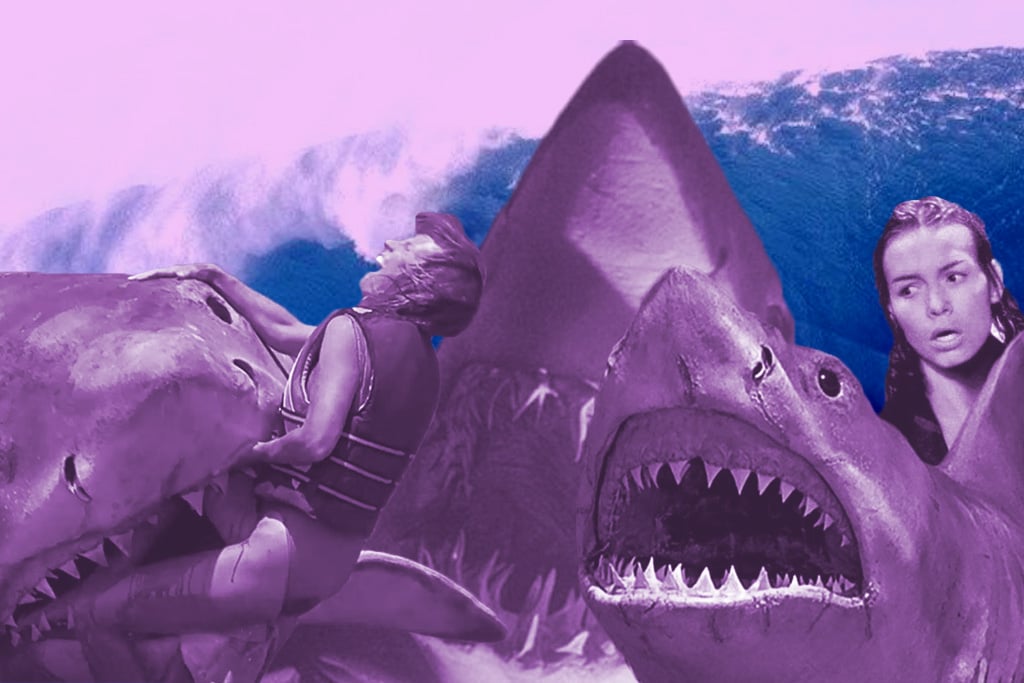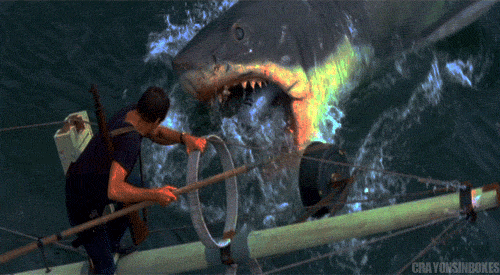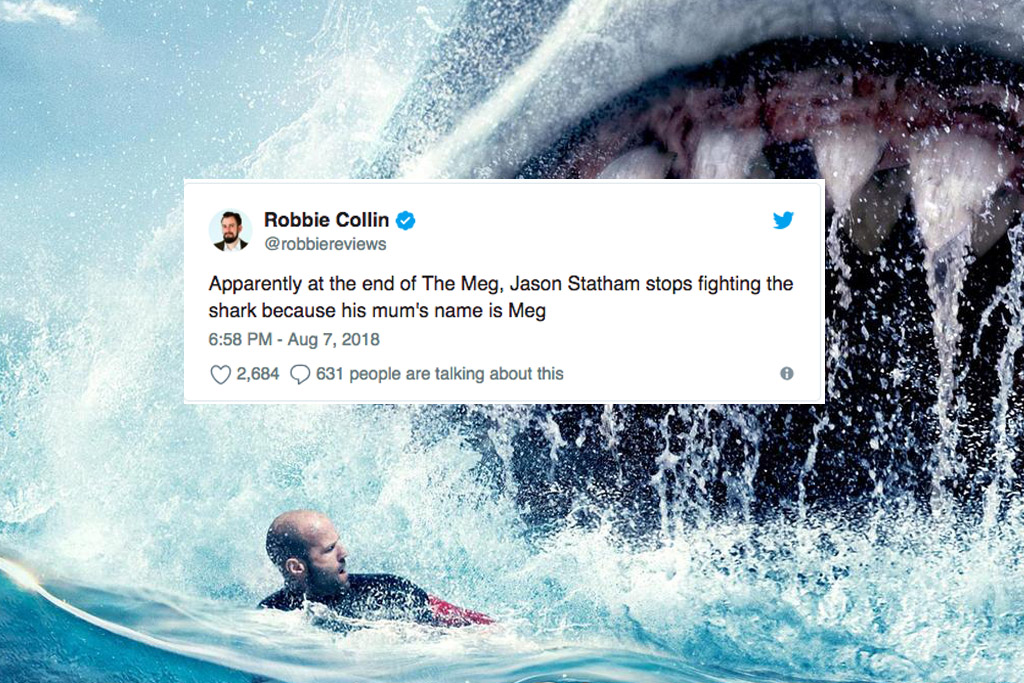From ‘Jaws To ‘The Meg’: A Deep Dive Into Great Shark Movies
Bigger isn’t always necessarily better when it comes to shark movies.

Lets get this out of the way: there is only one genuinely great shark movie. Not ‘so bad it’s good’ or ‘low key good in spite of itself’, just straight up great. And that movie is Jaws. Ever since Steven Spielberg’s seminal OG summer blockbuster swam into our lives in 1975, every shark movie has been chasing its dorsal fin. Including The Meg.
With Jason Statham’s The Meg taking a big-ass bite out of the box-office over the past month, audiences seem to be loving the high-concept creature feature. Yet with a 70ft Megalodon at the centre of the film, bigger isn’t always necessarily better when it comes to great shark movies.
The weirdly bloodless The Meg is just the latest in a long line of summer shark blockbusters, featuring all the hallmarks of a Jason Statham movie — turtlenecks, heroics and one-liners delivered with an arched eyebrow — it also has also replaced the vanilla shark with a giant “swimming fossil”.
It’s consciously meant to fall into the category of big, dumb shark movies like Deep Blue Sea and Sharknado. There have also been gritty shark movies (Open Water, The Reef), specific shark movies (The Shallows, 47 Meters Down) and straight-to-DVD shark movies (Ghost Shark, Sharktopus).
Yet in the eternal quest to imitate and duplicate, there are essential elements every shark movie needs in order to be great.

The Shark
Yeah, okay, that may seem like an extreme duh level observation but it’s crazy how many times the integral ingredient of a shark movie gets fucked up.
Keyword here being ‘shark’, singular, rather than ‘sharks’, plural. Because if we’ve learned anything from the Sharknado franchise, it’s that if you can’t get one shark right you sure as shit can’t get a tornado full of them right.
Jaws, naturally, set the bar with a mechanical shark lovingly nicknamed by the crew ‘Bruce’ (fun fact: that’s where the shark from Finding Nemo gets his name). Yet as anyone who listens to the podcast Inside Jaws knows, it was a troubled production with the shark malfunctioning so often Spielberg had to shoot around it, showing it only in flashes of teeth and fin for the first half of the movie.

It unintentionally became one of the great devices of suspense, with ‘Bruce’ downright terrifying by the time he’s fully revealed laying on the deck of the Orca and chomping Quint in half … even if it does look a little dated by 2018 standards.
However, there was a combination of elements: shark experts Ron and Valerie Taylor were also employed by the production to get real footage of sharks, which was spliced throughout the movie. It’s a principal filmmakers have struggled to emulate, leaning way harder on digital effects than practical ones.
Sure, not every movie has a 70ft shark like The Meg where you need to apply CGI to bring it to life, but the differences in films like Open Water and The Reef — which both used footage of real sharks — and the giggle-worthy monsters from Shark Night 3D are significant. When the amphibious shark monster from Peter Benchley’s 1998 TV mini-series Creature looks better than the villain from 2016’s The Shallows, you’ve got a problem.
On set of Jaws movie, an effectsman repairs the shark's teeth, 1974. pic.twitter.com/hW16D7D3tW
— Lost In History (@HistoryToLearn) August 20, 2018
The Bait
It needs to be a combination of a) people you’re rooting for b) people rooting and c) people you want to see get rooted.
For example, Jaws opened with option b in what is now an iconic scene. Throughout the course of all shark movies, there are people you want to watch triumph (Chief Brody) and those you want to see get chomped (Mayor Vaughn). It’s rumoured that in test screenings for Deep Blue Sea, audiences reacted so positively to LL Cool J’s chef character Preacher that producers rewrote and reshot the ending so that he triumphed in the finale with Thomas Jane.
It was Saffron Burrows who ended up having a heroic death instead. You need those moments to whoop, as well as the ones where you nod with sick satisfaction as someone’s head dips below the water and blood comes bubbling to the surface.
It remains a big issue with The Meg, which starts with a cast large enough for you to get excited about the prospect of a bunch of them getting eating in a myriad of creative ways before the end credits roll fin.
Put simply, not enough people die: the body count of central characters remains low and even the toll of randoms turned into chum is disappointing.
The Cage
That’s a metaphor for ‘the setting’, basically, cos we’re trying to keep this whole thing ocean themed and what not.
The equation of shark + people = movie doesn’t properly work. There needs to be shark + people + setting = fully sick movie. Jaws was set on an island, which in and of itself is a terrifying notion when said island is plagued by a man-eating shark just looking for 11-year-old boys innocently swimming on lilos.
It’s the specificity of it being Amityville Island — a town whose economy relies on seasonal holiday trade — where you get much of the nuance throughout the course of the story.
Similarly, one of the other most financially successful shark movies, Open Water, was based on the true story of Tom and Eileen Lonergan who were left behind by their dive boat near the Great Barrier Reef in 1998. Their bodies were never found and a coroner ruled it was likely they had succumbed to drowning or shark attack.
The horrific notion was recreated in the movie, with directors filming in the open ocean and using real sharks. Utilising low-budget techniques popular at the time with flicks like The Blair Witch Project, the barrier between the events happening on screen and the audience felt thin.
Open Water went on to gross over $55M at the international box-office on just a $120,000 budget. It’s a recipe 47 Meters Down used last year, with Mandy Moore and Claire Holt playing two sisters who get trapped at the bottom of the ocean after going cage diving in shark-infested waters. Leaning hard into the survivalist subgenre, the specificity of the movie was an advantage with critics feeling so-so about the film but audiences supporting it with a $61M worldwide gross on a $5M budget.
The Noms
It’s why The Shallows could never elevate itself past lacklustre B-grade schlock: none of the noms were particularly good, with minimal blood deployed (hello wide cinematic release rating) and minimal tension before a shark just sky bombs a dude with an open mouth.
Compare the short and unsatisfying end game of The Shallows body count to the encroaching sense of dread you feel in Jaws when the dorsal fin slips below the surface as the shark swims towards the boys playing unaware in a lagoon nearby. You know something bad is coming and Spielberg’s skilled filmmaking builds towards it.
Deep Blue Sea has some epic noms: almost too many to count. There’s Samuel L Jackson getting munched midway through his call to action speech, which is great.
The father of all eight Viking Skarsgård children, Stellan, is killed horribly at least three different ways. LL Cool J’s bird cops it and so too does Aussie actress Jacqueline McKenzie delivering one of the epic, enduring death rattles as she emerges from the water in the mouth of a shark.
Aussie director Andrew Traucki had already delivered a savvy crocodile thriller in Black Water when he followed up with The Reef in 2010, based on the true story of Ray Boundy from the eighties off the coast of Queensland. The movie – which live streamed its production online – exploited the stakes of a small cast so that the audience felt every death and every bite from the Great White Shark that stalks them.
It’s 2018 people doesn’t want killer shark movie people want movies with gentle giant shark friend you can pet and bond with
— Selpooky (@selpocky) August 22, 2018
Award For Best Supporting Shark In An Otherwise Non-Shark Movie
The Perfect Storm: The shark who nearly ate Mark Wahlberg in a surprise sneak attack onboard the Andrea Gail
Lara Croft: Tomb Raider – The Cradle Of Life: The emotive shark who is punched in the nose by Angelina Jolie, before being ridden to the surface
Austin Powers in Goldmember: Sharks with frikken laser beams attached to their frikken heads
Finding Nemo: Bruce, nuff said
Into The Blue: The shark who bites a guy in the dick after Jessica Alba kicks him directly into the sea creature’s path

Fin.
—
Maria Lewis is a journalist, screenwriter and author of It Came From The Deep and the Who’s Afraid? novel series, available worldwide.
